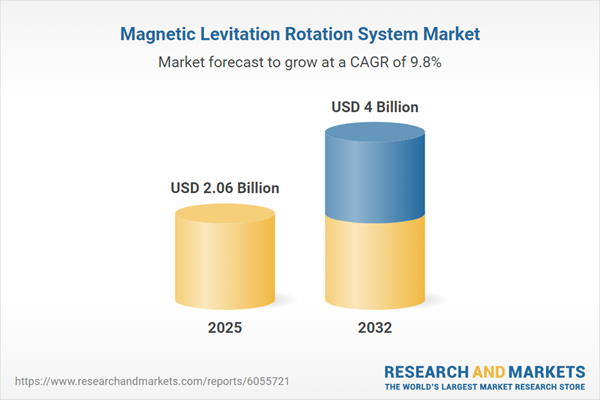Speak directly to the analyst to clarify any post sales queries you may have.
Magnetic levitation rotation systems are redefining industrial and commercial standards for precision, efficiency, and reliability in rotational applications. Senior decision-makers seeking frictionless, high-performance solutions will find this market analysis essential for strategic investment and operational planning.
Market Snapshot: Robust Growth Amid Technological and Market Evolution
The Magnetic Levitation Rotation System Market grew from USD 1.88 billion in 2024 to USD 2.06 billion in 2025, and is projected to reach USD 4.00 billion by 2032 at a CAGR of 9.84%.
This expansion is fueled by rapid advancements in control systems, new magnetic material technologies, and adoption across industries prioritizing high-precision and low-maintenance rotational solutions. As frictionless propulsion and predictive digital integration move beyond prototypes, both established sectors and emerging applications are accelerating market demand.Scope & Segmentation: Comprehensive Coverage and Key Growth Drivers
This report delivers a structured analysis of the magnetic levitation rotation market across multiple dimensions:
- Components: Control systems (feedback and stabilization mechanisms), magnets (including electromagnets, permanent, and superconducting types), power supply units, sensors and actuators, structural elements such as housing, support structures, and levitation tracks
- Technology: Electromagnetic, pneumatic, superconducting, hybrid configurations like electromagnetic-pneumatic and electromagnetic-superconducting systems
- Operational Speed: High-speed, medium-speed, and low-speed system requirements
- Application: Energy systems (hydroelectric dams and wind turbines), industrial automation (assembly lines, automated storage), transportation (cargo systems, high-speed trains, urban transit)
- End-Use Industry: Aerospace, consumer electronics, energy, healthcare, industrial and manufacturing, transportation
- Sales Channel: Direct sales, distributors, and online platforms
- Regions: Americas (including North America and Latin America), Europe, Middle East and Africa, Asia-Pacific
- Company Analysis: Evaluation of key players such as AB SKF, ABB Ltd., Central Japan Railway Company, CRRC Corporation Limited, Siemens AG, Hitachi, Hyundai Rotem, and others
Key Takeaways: Strategic Insights for Senior Decision-Makers
- Magnetic levitation rotation systems enable shift away from mechanical friction, supporting industries that demand precise, contamination-free motion and reduced maintenance.
- Integration with digital twin frameworks and machine learning is driving a transition toward proactive lifecycle management and predictive maintenance, optimizing uptime and resource allocation.
- Technological innovation, notably in the areas of additive manufacturing and superconducting materials, has broadened system performance boundaries and scalability for industrial adoption.
- Global adoption is being reshaped by collaborations between large manufacturers, agile startups, and research institutions, accelerating advancements in modular product design and streamlined procurement.
- Diversity in regional drivers—from energy efficiency upgrades in the Americas to rapid transit investments in Asia-Pacific—necessitates tailored go-to-market and partnership strategies.
Tariff Impact: Navigating Post-2025 Supply Chain and Cost Shifts
Recent United States tariffs on key components have introduced significant fluctuations in supply chain dynamics and input costs. Manufacturers are responding by localizing production, forging long-term supplier agreements, and exploring alternative materials to manage volatility and sustain competitive pricing. Domestic producers may realize short-term advantages, while global supply chains recalibrate through new trade agreements and joint ventures. Strategic adaptation to these tariff-driven pressures is critical for maintaining profitability and operational resilience.
Methodology & Data Sources
The analysis integrates primary interviews with industry executives, engineers, and procurement leaders, complemented by secondary research from technical journals, patents, and regulatory sources. Industry expert panels reviewed and validated findings, ensuring robust insight into market segmentation, cost structures, and the impact of regulatory changes.
Why This Report Matters for Decision-Makers
- Enables leaders to align R&D, digital integration, and supply chain strategies with emerging market demands and regulatory requirements.
- Provides actionable benchmarks and segmentation to inform investment, market entry, or portfolio expansion decisions.
- Highlights key competitor strategies and innovation trends that can shape future partnership or acquisition opportunities.
Conclusion: Strategic Considerations for Sustainable Advancement
Magnetic levitation rotation systems are advancing rapidly, offering decision-makers significant opportunities for efficiency, reliability, and innovation. Proactive collaboration, investment in digital platforms, and adaptive regional strategies will position market participants for sustainable growth in this high-potential sector.
Table of Contents
3. Executive Summary
4. Market Overview
7. Cumulative Impact of Artificial Intelligence 2025
Companies Mentioned
The companies profiled in this Magnetic Levitation Rotation System market report include:- AB SKF
- ABB Ltd.
- AMT, Inc.
- BiVACOR Inc.
- Calnetix Technologies, LLC.
- Central Japan Railway Company
- Crealev BV by Appear Inc.
- CRRC Corporation Limited
- Evico GmbH
- General Atomics
- Hitachi, Ltd.
- Hyundai Rotem Co.
- IronLev by IronBox srl
- Kawasaki Heavy Industries, Ltd.
- Levitronix GmbH
- MagLev Aero Inc.
- Mitsubishi Electric Corporation
- Nevomos by JMR Technologies
- Physik Instrumente (PI) SE & Co. KG
- Rockwell Automation, Inc.
- Siemens AG
- SpinDrive Oy.
- Suzhou Supermag Intelligent Technology Co., Ltd.
- The Boeing Company
- The China Aerospace Science and Industry Corporation (CASIC)
Table Information
| Report Attribute | Details |
|---|---|
| No. of Pages | 188 |
| Published | November 2025 |
| Forecast Period | 2025 - 2032 |
| Estimated Market Value ( USD | $ 2.06 Billion |
| Forecasted Market Value ( USD | $ 4 Billion |
| Compound Annual Growth Rate | 9.8% |
| Regions Covered | Global |
| No. of Companies Mentioned | 26 |









